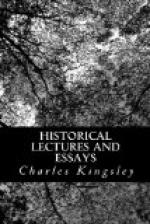Red as the blood which flowed from
stricken deer,
White as the snow on which that
blood ran down,
Black as the raven who drank up
that blood;
—and possibly, as in the case of Brian Boru’s mother, had given his fair-haired sister in marriage to some Irish prince, and could not resist the spell of their new creed, and the spell too, it may be, of some sister of theirs who had long given up all thought of earthly marriage to tend the undying fire of St. Bridget among the consecrated virgins of Kildare.
I am not drawing from mere imagination. That such things must have happened, and happened again and again, is certain to anyone who knows, even superficially, the documents of that time. And I doubt not that, in manners as well as in religion, the Norse were humanised and civilised by their contact with the Celts, both in Scotland and in Ireland. Both peoples had valour, intellect, imagination: but the Celt had that which the burly angular Norse character, however deep and stately, and however humorous, wanted; namely, music of nature, tenderness, grace, rapidity, playfulness; just the qualities, combining with the Scandinavian (and in Scotland with the Angle) elements of character which have produced, in Ireland and in Scotland, two schools of lyric poetry second to none in the world.
And so they were converted to what was then a dark and awful creed; a creed of ascetic self-torture and purgatorial fires for those who escape the still more dreadful, because endless, doom of the rest of the human race. But, because it was a sad creed, it suited better, men who had, when conscience re-awakened in them, but too good reason to be sad; and the minsters and cloisters which sprang up over the whole of Northern Europe, and even beyond it, along the dreary western shores of Greenland itself, are the symbols of a splendid repentance for their own sins and for the sins of their forefathers.
Gudruna herself, of whom I spoke just now, one of those old Norse heroines who helped to discover America, though a historic personage, is a symbolic one likewise, and the pattern of a whole class. She too, after many journeys to Iceland, Greenland, and Winland, goes on a pilgrimage to Rome, to get, I presume, absolution from the Pope himself for all the sins of her strange, rich, stormy, wayward life.




